Plasmonic Metal Nanostructures Meet Triplet–Triplet Annihilation-Based Photon Upconversion Systems: Performance Improvements and Application Trends
Abstract
1. Introduction
2. Overview of Recent Studies on Sensitizers in TTA-UC Systems
3. Performance Improvement in TTA-UC Systems Utilizing Plasmonic Metal Nanostructures
3.1. Theoretical Prediction for Plasmon-Enhanced Upconverted Emission
3.2. Plasmonic TTA-UC Systems
3.3. Application Trends in Plasmonic TTA-UC Systems
4. Outlook
Author Contributions
Funding
Data Availability Statement
Conflicts of Interest
References
- Wang, F.; Banerjee, D.; Liu, Y.; Chen, X.; Liu, X. Upconversion Nanoparticles in Biological Labeling, Imaging, and Therapy. Analyst 2010, 135, 1839–1854. [Google Scholar] [CrossRef] [PubMed]
- Auzel, F. Upconversion and Anti-Stokes Processes with f and d Ions in Solids. Chem. Rev. 2004, 104, 139–173. [Google Scholar] [CrossRef] [PubMed]
- Schmidt, T.W.; Castellano, F.N. Photochemical Upconversion: The Primacy of Kinetics. J. Phys. Chem. Lett. 2014, 5, 4062–4072. [Google Scholar] [CrossRef] [PubMed]
- Ye, C.; Zhou, L.; Wang, X.; Liang, Z. Photon Upconversion: From Two-Photon Absorption (TPA) to Triplet-Triplet Annihilation (TTA). Phys. Chem. Chem. Phys. 2016, 18, 10818–10835. [Google Scholar] [CrossRef] [PubMed]
- Parker, C.A.; Hatchard, C.G. Triplet-Singlet Emission in Fluid Solutions Phosphorescence of EOSIN. Trans. Faraday Soc. 1961, 57, 1894–1904. [Google Scholar] [CrossRef]
- Baluschev, S.; Miteva, T.; Yakutkin, V.; Nelles, G.; Yasuda, A.; Wegner, G. Up-Conversion Fluorescence: Noncoherent Excitation by Sunlight. Phys. Rev. Lett. 2006, 97, 143903. [Google Scholar] [CrossRef] [PubMed]
- Gallaher, J.K.; Wright, K.M.; Frazer, L.; Macqueen, R.W.; Crossley, M.J.; Castellano, F.N.; Schmidt, T.W. High Efficiency Deep Red to Yellow Photochemical Upconversion under Solar Irradiance. Energy Environ. Sci. 2021, 14, 5541–5551. [Google Scholar] [CrossRef]
- MacQueen, R.W.; Cheng, Y.Y.; Danos, A.N.; Lips, K.; Schmidt, T.W. Action Spectrum Experiment for the Measurement of Incoherent Photon Upconversion Efficiency under Sun-like Excitation. RSC Adv. 2014, 4, 52749–52756. [Google Scholar] [CrossRef]
- Li, C.; Koenigsmann, C.; Deng, F.; Hagstrom, A.; Schmuttenmaer, C.A.; Kim, J.H. Photocurrent Enhancement from Solid-State Triplet-Triplet Annihilation Upconversion of Low-Intensity, Low-Energy Photons. ACS Photonics 2016, 3, 784–790. [Google Scholar] [CrossRef]
- Duan, P.; Yanai, N.; Nagatomi, H.; Kimizuka, N. Photon Upconversion in Supramolecular Gel Matrixes: Spontaneous Accumulation of Light-Harvesting Donor-Acceptor Arrays in Nanofibers and Acquired Air Stability. J. Am. Chem. Soc. 2015, 137, 1887–1894. [Google Scholar] [CrossRef]
- Baluschev, S.; Yakutkin, V.; Miteva, T.; Wegner, G.; Roberts, T.; Nelles, G.; Yasuda, A.; Chernov, S.; Aleshchenkov, S.; Cheprakov, A. A General Approach for Non-Coherently Excited Annihilation up-Conversion: Transforming the Solar-Spectrum. New J. Phys. 2008, 10, 013007. [Google Scholar] [CrossRef]
- Liu, Q.; Xu, M.; Yang, T.; Tian, B.; Zhang, X.; Li, F. Highly Photostable Near-IR-Excitation Upconversion Nanocapsules Based on Triplet-Triplet Annihilation for in Vivo Bioimaging Application. ACS Appl. Mater. Interfaces 2018, 10, 9883–9888. [Google Scholar] [CrossRef]
- Park, J.; Xu, M.; Li, F.; Zhou, H.C. 3D Long-Range Triplet Migration in a Water-Stable Metal-Organic Framework for Upconversion-Based Ultralow-Power in Vivo Imaging. J. Am. Chem. Soc. 2018, 140, 5493–5499. [Google Scholar] [CrossRef] [PubMed]
- Di, D.; Yang, L.; Richter, J.M.; Meraldi, L.; Altamimi, R.M.; Alyamani, A.Y.; Credgington, D.; Musselman, K.P.; MacManus-Driscoll, J.L.; Friend, R.H. Efficient Triplet Exciton Fusion in Molecularly Doped Polymer Light-Emitting Diodes. Adv. Mater. 2017, 29, 1605987. [Google Scholar] [CrossRef]
- Schulze, T.F.; Schmidt, T.W. Photochemical Upconversion: Present Status and Prospects for Its Application to Solar Energy Conversion. Energy Environ. Sci. 2015, 8, 103–125. [Google Scholar] [CrossRef]
- Kwon, O.S.; Kim, J.H.; Cho, J.K.; Kim, J.H. Triplet-Triplet Annihilation Upconversion in CdS-Decorated SiO2 Nanocapsules for Sub-Bandgap Photocatalysis. ACS Appl. Mater. Interfaces 2015, 7, 318–325. [Google Scholar] [CrossRef] [PubMed]
- Chandrasekaran, S.; Ngo, Y.L.T.; Sui, L.; Kim, E.J.; Dang, D.K.; Chung, J.S.; Hur, S.H. Highly Enhanced Visible Light Water Splitting of CdS by Green to Blue Upconversion. Dalton Trans. 2017, 46, 13912–13919. [Google Scholar] [CrossRef]
- Kim, J.H.; Kim, J.H. Encapsulated Triplet-Triplet Annihilation-Based Upconversion in the Aqueous Phase for Sub-Band-Gap Semiconductor Photocatalysis. J. Am. Chem. Soc. 2012, 134, 17478–17481. [Google Scholar] [CrossRef] [PubMed]
- Barawi, M.; Fresno, F.; Pérez-Ruiz, R.; de La Peña O’Shea, V.A. Photoelectrochemical Hydrogen Evolution Driven by Visible-to-Ultraviolet Photon Upconversion. ACS Appl. Energy Mater. 2019, 2, 207–211. [Google Scholar] [CrossRef]
- Ronchi, A.; Monguzzi, A. Developing Solid-State Photon Upconverters Based on Sensitized Triplet-Triplet Annihilation. J. Appl. Phys. 2021, 129, 050901. [Google Scholar] [CrossRef]
- Saenz, F.; Ronchi, A.; Mauri, M.; Kiebala, D.; Monguzzi, A.; Weder, C. Block Copolymer Stabilized Liquid Nanodroplets Facilitate Efficient Triplet Fusion-Based Photon Upconversion in Solid Polymer Matrices. ACS Appl. Mater. Interfaces 2021, 13, 43314–43322. [Google Scholar] [CrossRef] [PubMed]
- Monguzzi, A.; Mauri, M.; Bianchi, A.; Dibbanti, M.K.; Simonutti, R.; Meinardi, F. Solid-State Sensitized Upconversion in Polyacrylate Elastomers. J. Phys. Chem. C 2016, 120, 2609–2614. [Google Scholar] [CrossRef]
- Saenz, F.; Ronchi, A.; Mauri, M.; Vadrucci, R.; Meinardi, F.; Monguzzi, A.; Weder, C. Nanostructured Polymers Enable Stable and Efficient Low-Power Photon Upconversion. Adv. Funct. Mater. 2021, 31, 2004495. [Google Scholar] [CrossRef]
- Bennison, M.J.; Collins, A.R.; Zhang, B.; Evans, R.C. Rachel Organic Polymer Hosts for Triplet-Triplet Annihilation Upconversion Systems. Macromolecules 2021, 54, 5287–5303. [Google Scholar] [CrossRef] [PubMed]
- Simon, Y.C.; Weder, C. Low-Power Photon Upconversion through Triplet-Triplet Annihilation in Polymers. J. Mater. Chem. 2012, 22, 20817–20830. [Google Scholar] [CrossRef]
- Mayer, K.M.; Hafner, J.H. Localized Surface Plasmon Resonance Sensors. Chem. Rev. 2011, 111, 3828–3857. [Google Scholar] [CrossRef] [PubMed]
- Wei, H.; Yan, X.; Niu, Y.; Li, Q.; Jia, Z.; Xu, H. Plasmon–Exciton Interactions: Spontaneous Emission and Strong Coupling. Adv. Funct. Mater. 2021, 31, 2100889. [Google Scholar] [CrossRef]
- Lakowicz, J.R. Radiative Decay Engineering 5: Metal-Enhanced Fluorescence and Plasmon Emission. Anal. Biochem. 2005, 337, 171–194. [Google Scholar] [CrossRef]
- Bauch, M.; Toma, K.; Toma, M.; Zhang, Q.; Dostalek, J. Plasmon-Enhanced Fluorescence Biosensors: A Review. Plasmonics 2014, 9, 781–799. [Google Scholar] [CrossRef]
- Cheng, D.; Xu, Q.H. Separation Distance Dependent Fluorescence Enhancement of Fluorescein Isothiocyanate by Silver Nanoparticles. Chem. Commun. 2007, 3, 248–250. [Google Scholar] [CrossRef] [PubMed]
- Ray, P.C. Size and Shape Dependent Second Order Nonlinear Optical Properties of Nanomaterials and Their Application in Biological and Chemical Sensing. Chem. Rev. 2010, 110, 5332–5365. [Google Scholar] [CrossRef] [PubMed]
- Haefele, A.; Blumhoff, J.; Khnayzer, R.S.; Castellano, F.N. Getting to the (Square) Root of the Problem: How to Make Noncoherent Pumped Upconversion Linear. J. Phys. Chem. Lett. 2012, 3, 299–303. [Google Scholar] [CrossRef]
- Zhou, J.; Liu, Q.; Feng, W.; Sun, Y.; Li, F. Upconversion Luminescent Materials: Advances and Applications. Chem. Rev. 2015, 115, 395–465. [Google Scholar] [CrossRef] [PubMed]
- Zhao, J.; Ji, S.; Guo, H. Triplet-Triplet Annihilation Based Upconversion: From Triplet Sensitizers and Triplet Acceptors to Upconversion Quantum Yields. RSC Adv. 2011, 1, 937–950. [Google Scholar] [CrossRef]
- Singh-Rachford, T.N.; Castellano, F.N. Triplet Sensitized Red-to-Blue Photon Upconversion. J. Phys. Chem. Lett. 2010, 1, 195–200. [Google Scholar] [CrossRef]
- Baluschev, S.; Yakutkin, V.; Wegner, G.; Miteva, T.; Nelles, G.; Yasuda, A.; Chernov, S.; Aleshchenkov, S.; Cheprakov, A. Upconversion with Ultrabroad Excitation Band: Simultaneous Use of Two Sensitizers. Appl. Phys. Lett. 2007, 90, 181103. [Google Scholar] [CrossRef]
- Zhao, W.; Castellano, F.N. Upconverted Emission from Pyrene and Di-Tert-Butylpyrene Using Ir(Ppy) 3 as Triplet Sensitizer. J. Phys. Chem. A 2006, 110, 11440–11445. [Google Scholar] [CrossRef] [PubMed]
- Wu, W.; Guo, H.; Wu, W.; Ji, S.; Zhao, J. Organic Triplet Sensitizer Library Derived from a Single Chromophore (BODIPY) with Long-Lived Triplet Excited State for Triplet-Triplet Annihilation Based Upconversion. J. Org. Chem. 2011, 76, 7056–7064. [Google Scholar] [CrossRef] [PubMed]
- Singh-Rachford, T.N.; Castellano, F.N. Photon Upconversion Based on Sensitized Triplet-Triplet Annihilation. Coord. Chem. Rev. 2010, 254, 2560–2573. [Google Scholar] [CrossRef]
- Islangulov, R.R.; Kozlov, D.V.; Castellano, F.N. Low Power Upconversion Using MLCT Sensitizers. Chem. Commun. 2005, 30, 3776–3778. [Google Scholar] [CrossRef]
- Lissau, J.S.; Khelfallah, M.; Madsen, M. Near-Infrared to Visible Photon Upconversion by Palladium(II) Octabutoxyphthalocyanine and Rubrene in the Solid State. J. Phys. Chem. C 2021, 125, 25643–25650. [Google Scholar] [CrossRef]
- Wang, F.; Liu, X. Recent Advances in the Chemistry of Lanthanide-Doped Upconversion Nanocrystals. Chem. Soc. Rev. 2009, 38, 976–989. [Google Scholar] [CrossRef]
- Yanai, N.; Kozue, M.; Amemori, S.; Kabe, R.; Adachi, C.; Kimizuka, N. Increased Vis-to-UV Upconversion Performance by Energy Level Matching between a TADF Donor and High Triplet Energy Acceptors. J. Mater. Chem. C Mater. 2016, 4, 6447–6451. [Google Scholar] [CrossRef]
- Wu, T.C.; Congreve, D.N.; Baldo, M.A. Solid State Photon Upconversion Utilizing Thermally Activated Delayed Fluorescence Molecules as Triplet Sensitizer. Appl. Phys. Lett. 2015, 107, 031103. [Google Scholar] [CrossRef]
- Sasaki, Y.; Amemori, S.; Kouno, H.; Yanai, N.; Kimizuka, N. Near Infrared-to-Blue Photon Upconversion by Exploiting Direct S-T Absorption of a Molecular Sensitizer. J. Mater. Chem. C Mater. 2017, 5, 5063–5067. [Google Scholar] [CrossRef]
- Wei, Y.; Zheng, M.; Chen, L.; Zhou, X.; Liu, S. Near-Infrared to Violet Triplet-Triplet Annihilation Fluorescence Upconversion of Os(Ii) Complexes by Strong Spin-Forbidden Transition. Dalton Trans. 2019, 48, 11763–11771. [Google Scholar] [CrossRef] [PubMed]
- Haruki, R.; Sasaki, Y.; Masutani, K.; Yanai, N.; Kimizuka, N. Leaping across the Visible Range: Near-Infrared-to-Violet Photon Upconversion Employing a Silyl-Substituted Anthracene. Chem. Commun. 2020, 56, 7017–7020. [Google Scholar] [CrossRef]
- Sasaki, Y.; Amemori, S.; Yanai, N.; Kimizuka, N. Singlet-to-Triplet Absorption for Near-Infrared-to-Visible Photon Upconversion. Bull. Chem. Soc. Jpn. 2021, 94, 1760–1768. [Google Scholar] [CrossRef]
- Gholizadeh, E.M.; Prasad, S.K.K.; Teh, Z.L.; Ishwara, T.; Norman, S.; Petty, A.J.; Cole, J.H.; Cheong, S.; Tilley, R.D.; Anthony, J.E.; et al. Photochemical Upconversion of Near-Infrared Light from below the Silicon Bandgap. Nat. Photonics 2020, 14, 585–590. [Google Scholar] [CrossRef]
- Huang, Z.; Li, X.; Mahboub, M.; Hanson, K.M.; Nichols, V.M.; Le, H.; Tang, M.L.; Bardeen, C.J. Hybrid Molecule-Nanocrystal Photon Upconversion Across the Visible and Near-Infrared. Nano Lett. 2015, 15, 5552–5557. [Google Scholar] [CrossRef] [PubMed]
- Knyukshto, V.N.; Shul’ga, A.M.; Sagun, E.I.; Zen’kevich, É.I. Formation of Intersystem Crossing Transitions in Pd(II) and Pt(II) Porphyrins: Nonplanar Distortions of the Macrocycle and Charge Transfer States. Opt. Spectrosc. 2006, 100, 590–601, (English Translation of Optika i Spektroskopiya). [Google Scholar] [CrossRef]
- Uoyama, H.; Goushi, K.; Shizu, K.; Nomura, H.; Adachi, C. Highly Efficient Organic Light-Emitting Diodes from Delayed Fluorescence. Nature 2012, 492, 234–238. [Google Scholar] [CrossRef] [PubMed]
- Deng, Y.; Jiang, L.; Huang, L.; Zhu, T. Energy Flow in Hybrid Organic/Inorganic Systems for Triplet-Triplet Annihilation Upconversion. ACS Energy Lett. 2022, 7, 847–861. [Google Scholar] [CrossRef]
- Okumura, K.; Mase, K.; Yanai, N.; Kimizuka, N.; Okumura, K.; Mase, K.; Anai, N.Y.; Imizuka, N.K. Employing Core-Shell Quantum Dots as Triplet Sensitizers for Photon Upconversion. Chem. Eur. J. 2016, 22, 7721–7726. [Google Scholar] [CrossRef] [PubMed]
- Wu, M.; Congreve, D.N.; Wilson, M.W.B.; Jean, J.; Geva, N.; Welborn, M.; van Voorhis, T.; Bulovic, V.; Bawendi, M.G.; Baldo, M.A. Solid-State Infrared-to-Visible Upconversion Sensitized by Colloidal Nanocrystals. Nat. Photonics 2015, 10, 31–34. [Google Scholar] [CrossRef]
- Monguzzi, A.; Tubino, R.; Hoseinkhani, S.; Campione, M.; Meinardi, F. Low Power, Non-Coherent Sensitized Photon up-Conversion: Modelling and Perspectives. Phys. Chem. Chem. Phys. 2012, 14, 4322–4332. [Google Scholar] [CrossRef]
- Zhang, Q.; Uchaker, E.; Candelaria, S.L.; Cao, G. Nanomaterials for Energy Conversion and Storage. Chem. Soc. Rev. 2013, 42, 3127–3171. [Google Scholar] [CrossRef]
- Baluschev, S.; Yu, F.; Miteva, T.; Ahl, S.; Yasuda, A.; Nelles, G.; Knoll, W.; Wegner, G. Metal-Enhanced up-Conversion Fluorescence: Effective Triplet-Triplet Annihilation near Silver Surface. Nano Lett. 2005, 5, 2482–2484. [Google Scholar] [CrossRef]
- Poorkazem, K.; Hesketh, A.V.; Kelly, T.L. Plasmon-Enhanced Triplet-Triplet Annihilation Using Silver Nanoplates. J. Phys. Chem. C 2014, 118, 6398–6404. [Google Scholar] [CrossRef]
- Park, J.K.; Lee, G.Y.; Jung, K.; Ko, D.H.; Han, I.K.; Ko, H. Enhanced Triplet-Triplet Annihilation in Bicomponent Organic Systems by Using a Gap Plasmon Resonator. Nanoscale 2015, 7, 12828–12832. [Google Scholar] [CrossRef]
- Jin, S.; Sugawa, K.; Takeshima, N.; Tahara, H.; Igari, S.; Yoshinari, S.; Kurihara, Y.; Watanabe, S.; Enoki, M.; Sato, K.; et al. Precise Control of Localized Surface Plasmon Wavelengths Is Needed for Effective Enhancement of Triplet-Triplet Annihilation-Based Upconversion Emission. ACS Photonics 2018, 5, 5025–5037. [Google Scholar] [CrossRef]
- Mahala, C.; Sharma, M.D.; Basu, M. Near-Field and Far-Field Plasmonic Effects of Gold Nanoparticles Decorated on ZnO Nanosheets for Enhanced Solar Water Splitting. ACS Appl. Nano Mater. 2020, 3, 1153–1165. [Google Scholar] [CrossRef]
- Sugawa, K.; Yoshinari, S.; Watanabe, S.; Ishida, K.; Jin, S.; Takeshima, N.; Fukasawa, T.; Fukushima, M.; Katoh, R.; Takase, K.; et al. Performance Improvement of Triplet-Triplet Annihilation-Based Upconversion Solid Films through Plasmon-Induced Backward Scattering of Periodic Arrays of Ag and Al. Langmuir 2021, 37, 11508–11519. [Google Scholar] [CrossRef] [PubMed]
- Cao, X.; Hu, B.; Ding, R.; Zhang, P. Plasmon-Enhanced Homogeneous and Heterogeneous Triplet-Triplet Annihilation by Gold Nanoparticles. Phys. Chem. Chem. Phys. 2015, 17, 14479–14483. [Google Scholar] [CrossRef]
- Westbrook, E.G.; Zhang, P. Plasmon-Enhanced Triplet-Triplet Annihilation Upconversion of Post-Modified Polymeric Acceptors. Dalton Trans. 2018, 47, 8638–8645. [Google Scholar] [CrossRef] [PubMed]
- Kim, H.-i.; Weon, S.; Kang, H.; Hagstrom, A.L.; Kwon, O.S.; Lee, Y.S.; Choi, W.; Kim, J.H. Plasmon-Enhanced Sub-Bandgap Photocatalysis via Triplet-Triplet Annihilation Upconversion for Volatile Organic Compound Degradation. Environ. Sci. Technol. 2016, 50, 11184–11192. [Google Scholar] [CrossRef]
- Fang, J.; Chen, Y.; Wang, W.; Fang, L.; Lu, C.; Zhu, C.; Kou, J.; Ni, Y.; Xu, Z. Highly Efficient Photocatalytic Hydrogen Generation of G-C3N4-CdS Sheets Based on Plasmon-Enhanced Triplet–Triplet Annihilation Upconversion. Appl. Catal. B 2019, 258, 117762. [Google Scholar] [CrossRef]
- Fang, J.; Chen, Y.; Zhu, C.; Li, X.; Wang, W.; Lu, C.; Ni, Y.; Fang, L.; Xu, Z. Enhanced Triplet-Triplet Annihilation Upconversion by Photonic Crystals and Au Plasma Resonance for Efficient Photocatalysis. Catal. Sci. Technol. 2020, 10, 8325–8331. [Google Scholar] [CrossRef]
- Fang, J.; Zhou, C.; Chen, Y.; Fang, L.; Wang, W.; Zhu, C.; Ni, Y.; Lu, C. Efficient Photocatalysis of Composite Films Based on Plasmon-Enhanced Triplet-Triplaet Annihlation. ACS Appl. Mater. Interfaces 2020, 12, 717–726. [Google Scholar] [CrossRef] [PubMed]
- Bujak, Ł.; Narushima, K.; Sharma, D.K.; Hirata, S.; Vacha, M. Plasmon Enhancement of Triplet Exciton Diffusion Revealed by Nanoscale Imaging of Photochemical Fluorescence Upconversion. J. Phys. Chem. C 2017, 121, 25479–25486. [Google Scholar] [CrossRef]
- Takeshima, N.; Sugawa, K.; Tahara, H.; Jin, S.; Wakui, H.; Fukushima, M.; Tokuda, K.; Igari, S.; Kanakubo, K.; Hayakawa, Y.; et al. Plasmonic Silver Nanoprism-Induced Emissive Mode Control between Fluorescence and Phosphorescence of a Phosphorescent Palladium Porphyrin Derivative. ACS Nano 2019, 13, 13244–13256. [Google Scholar] [CrossRef] [PubMed]
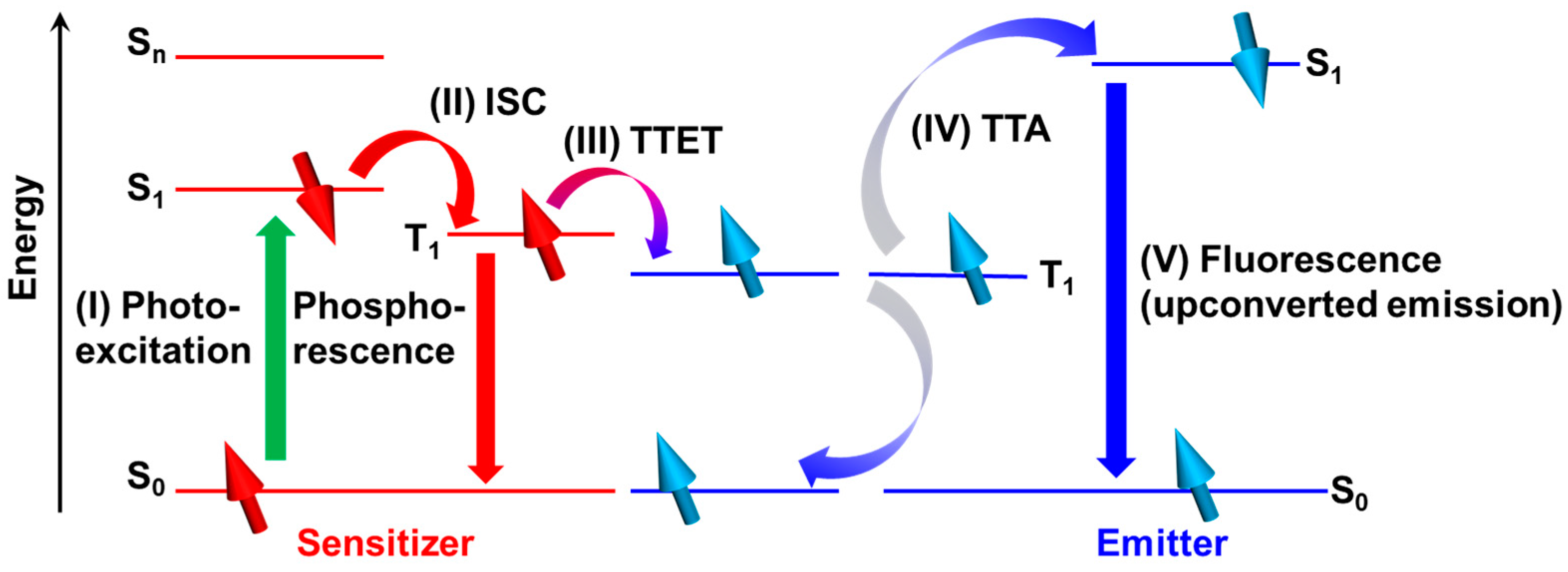
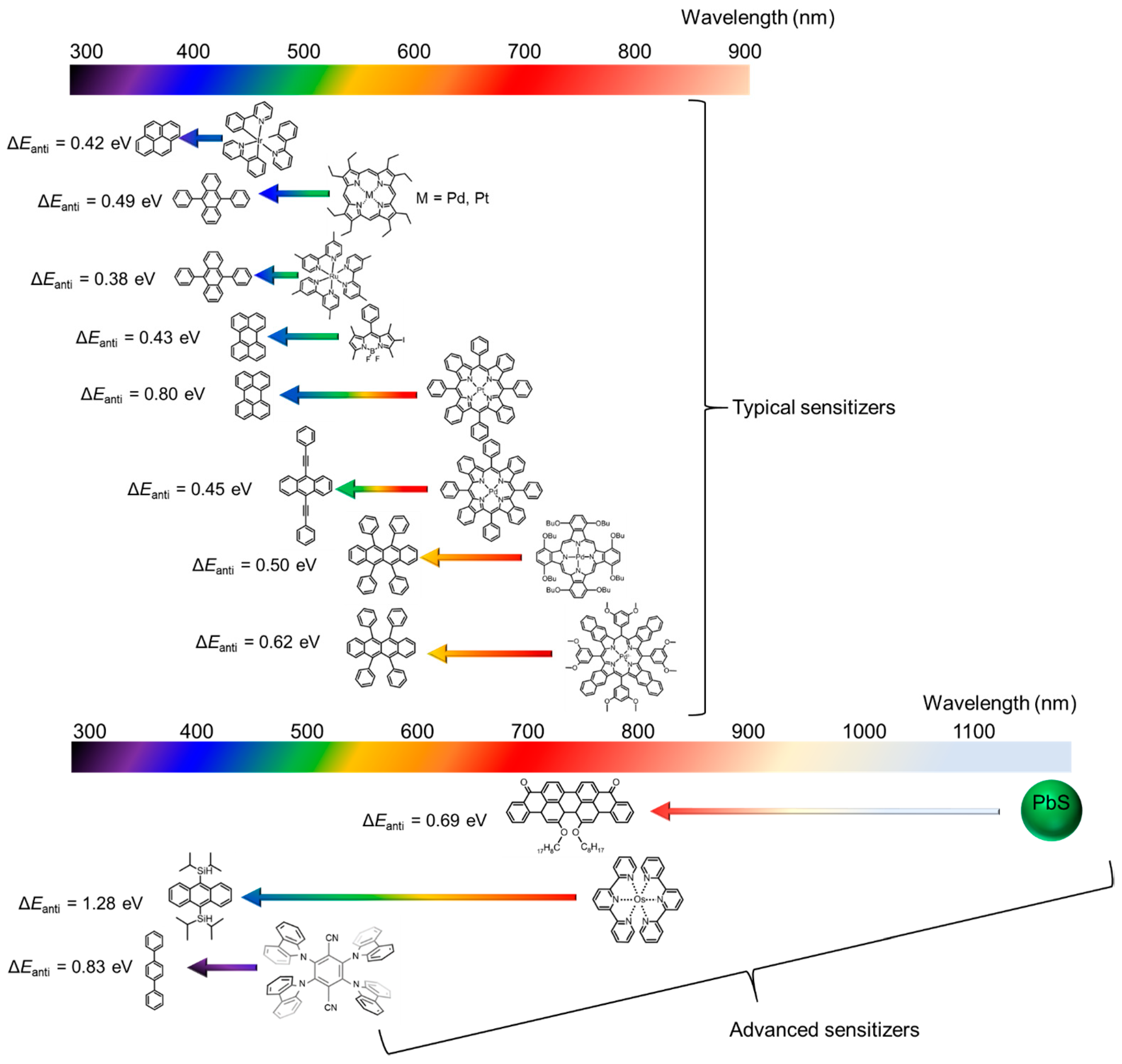
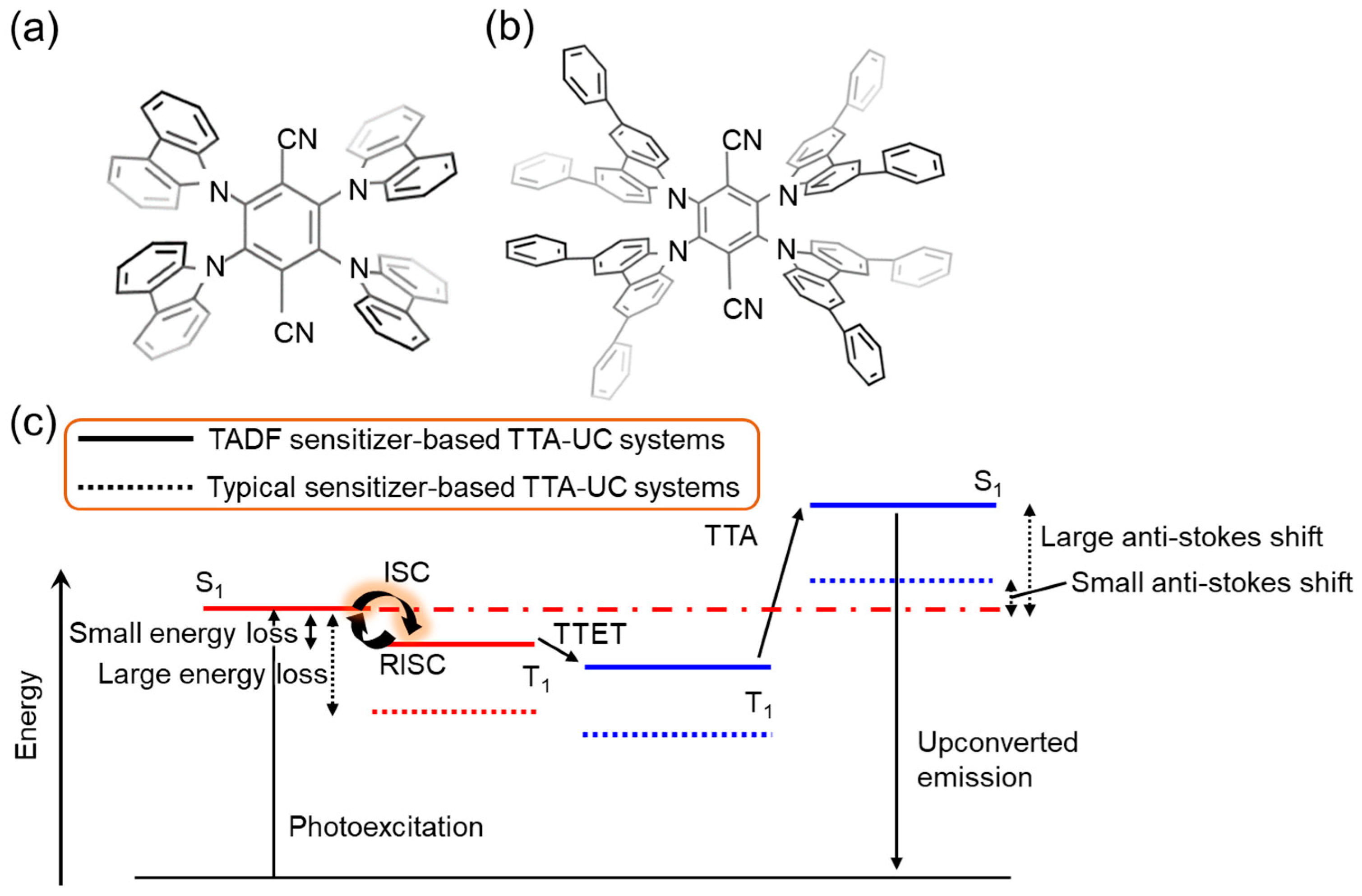
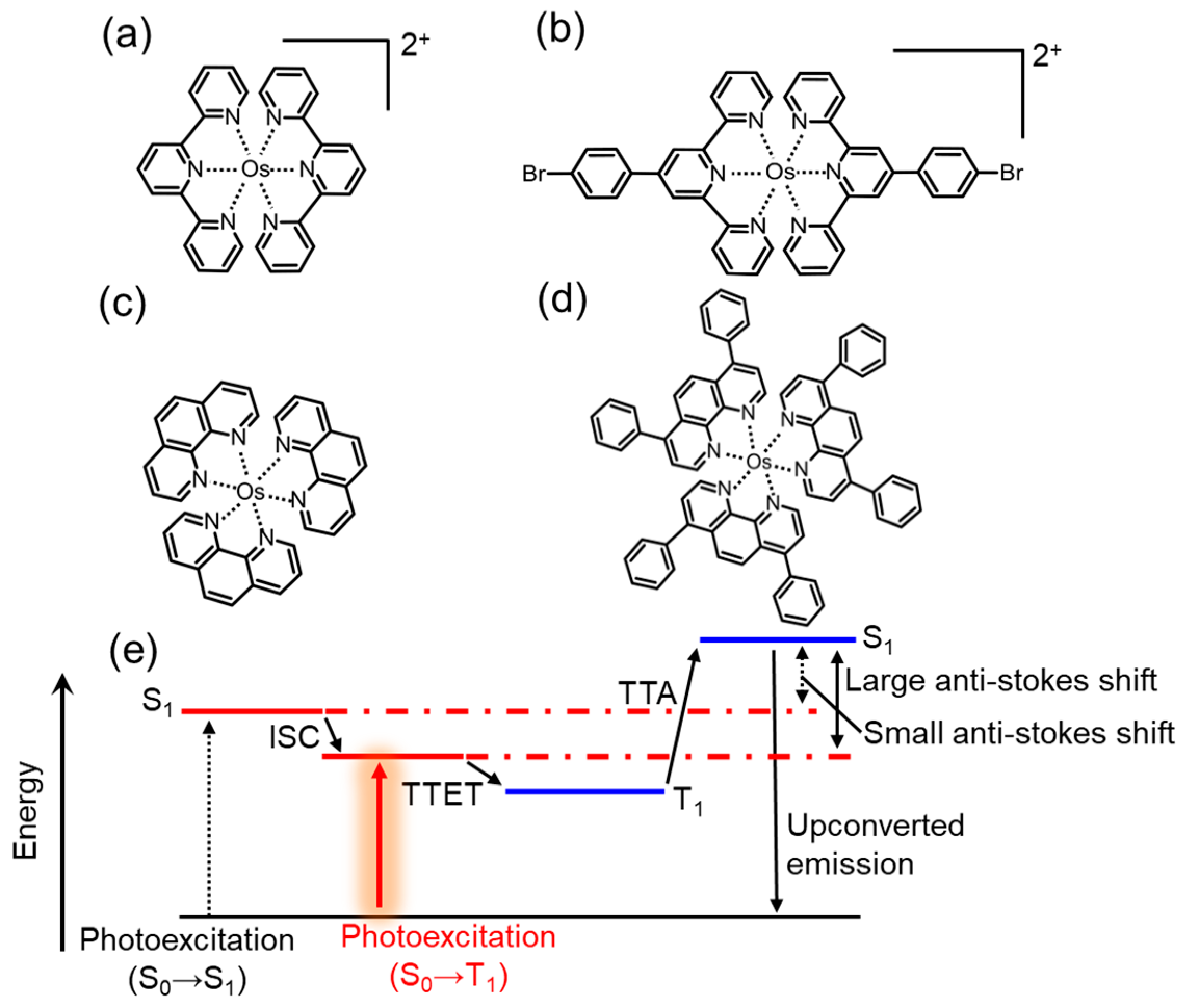
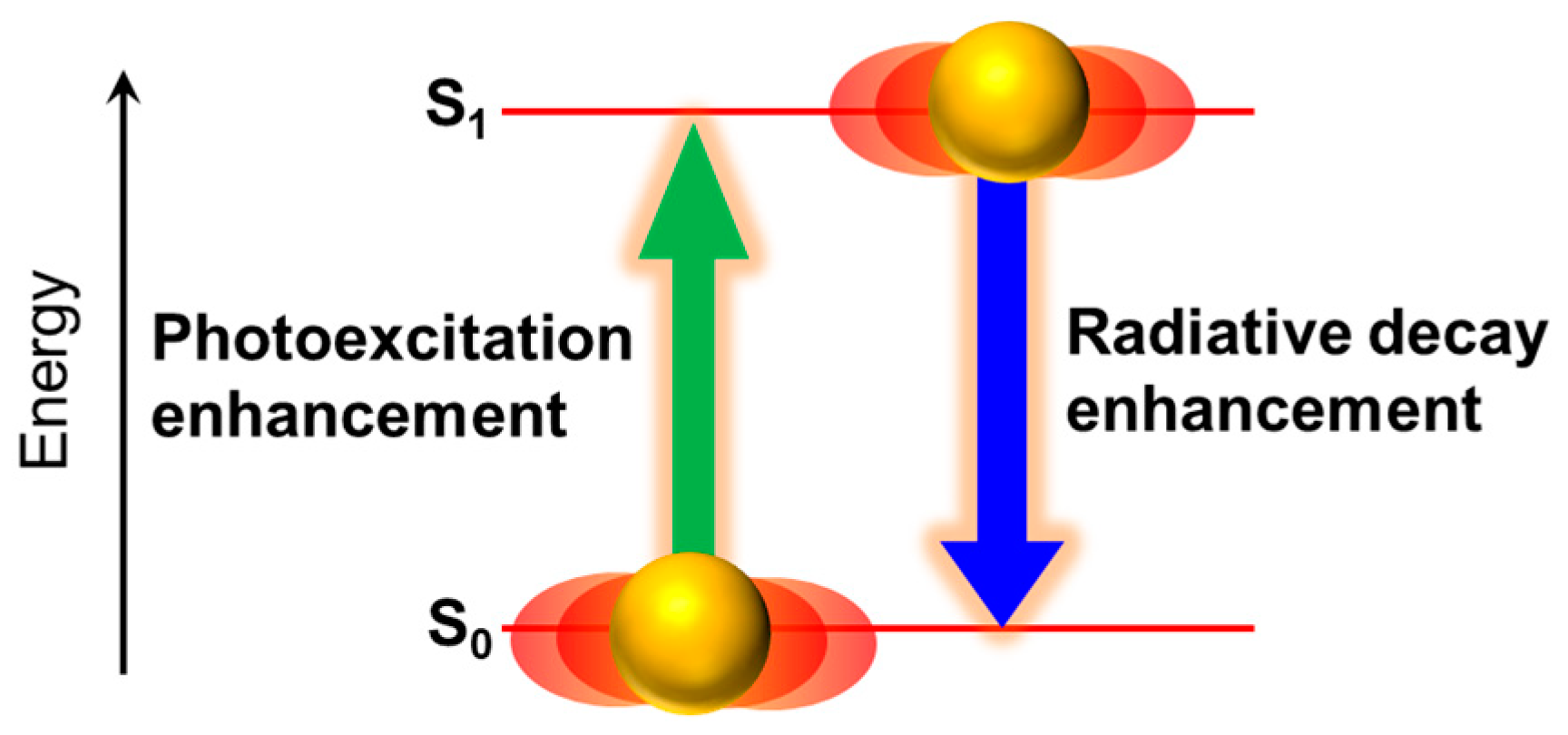
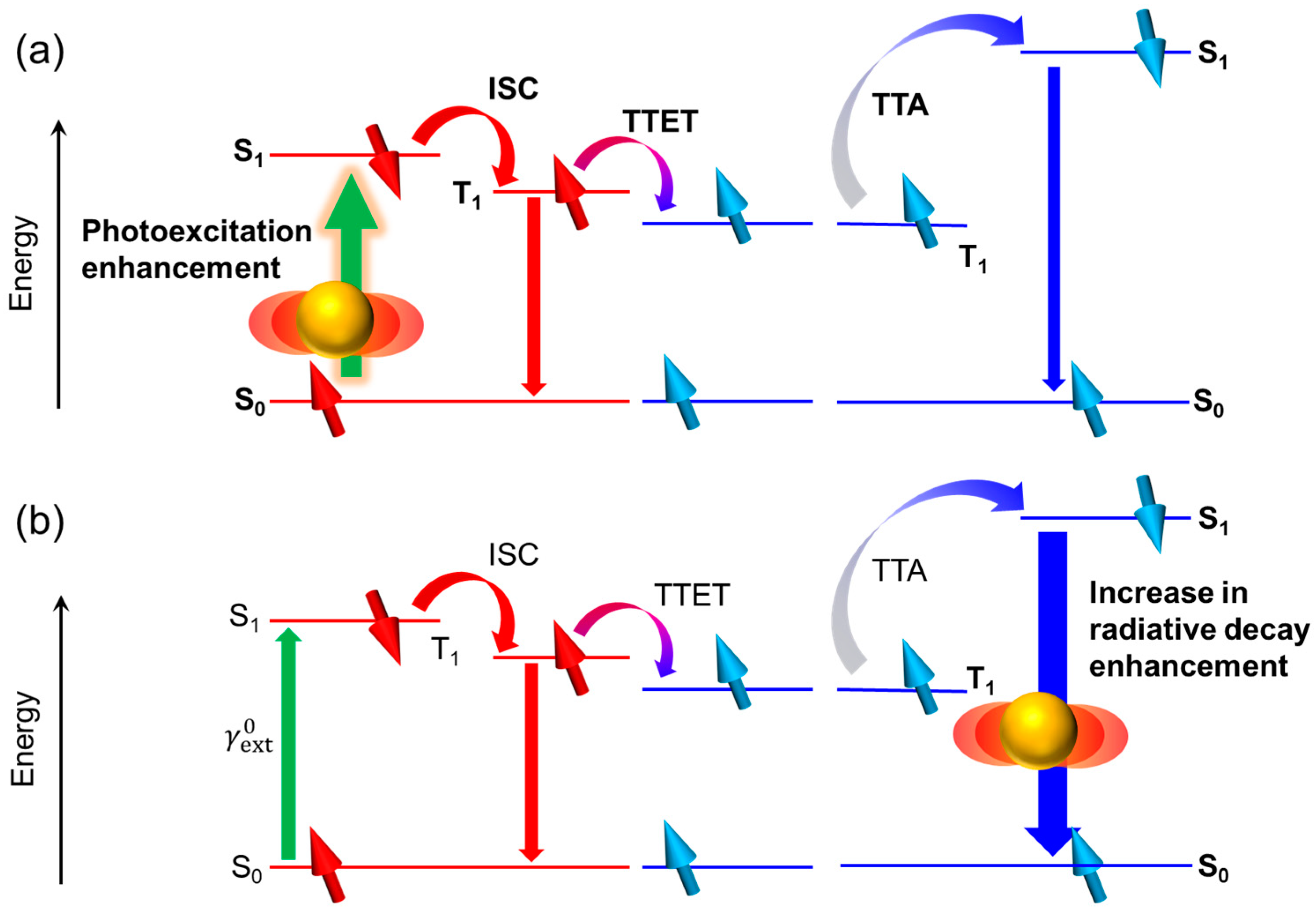
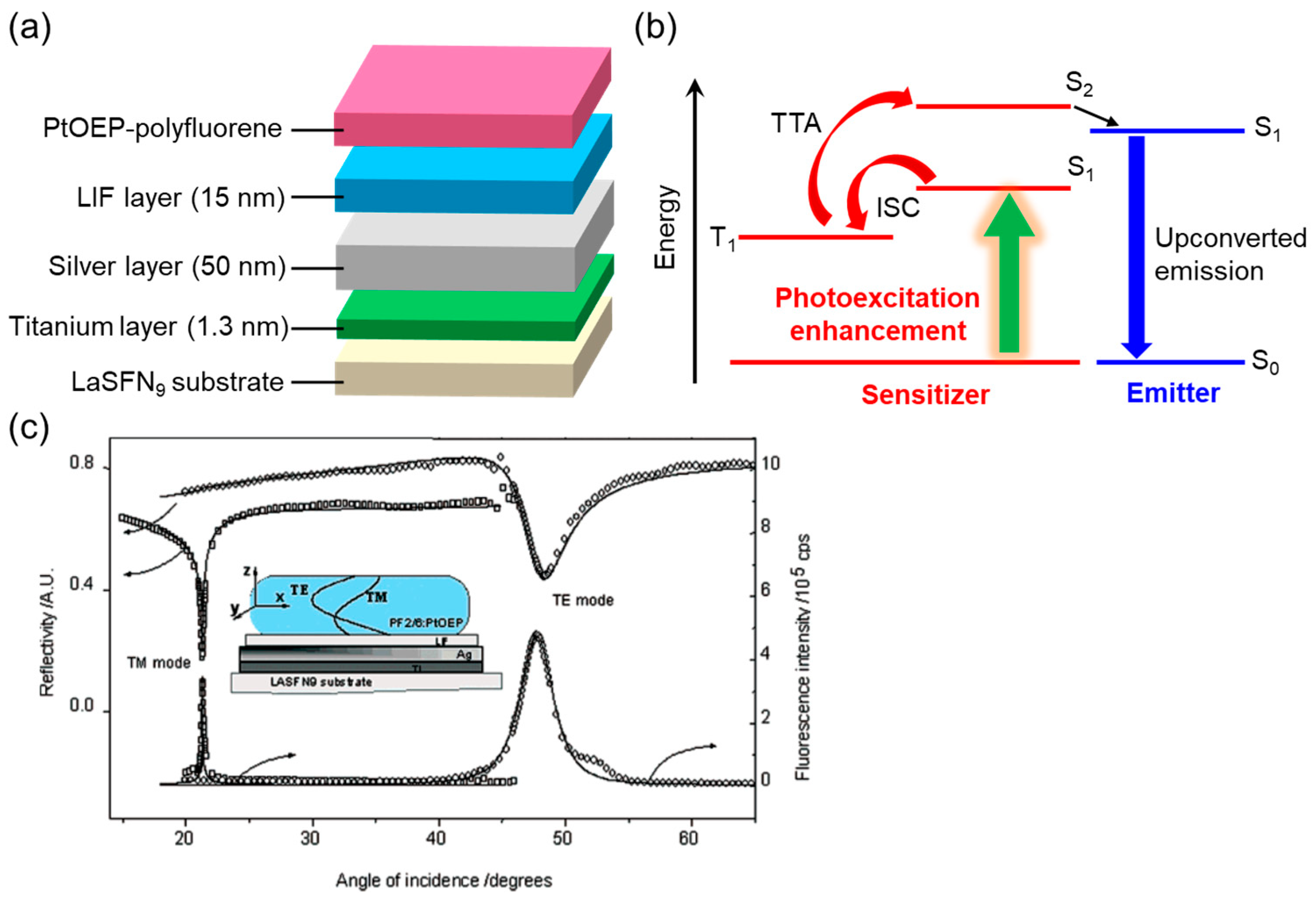
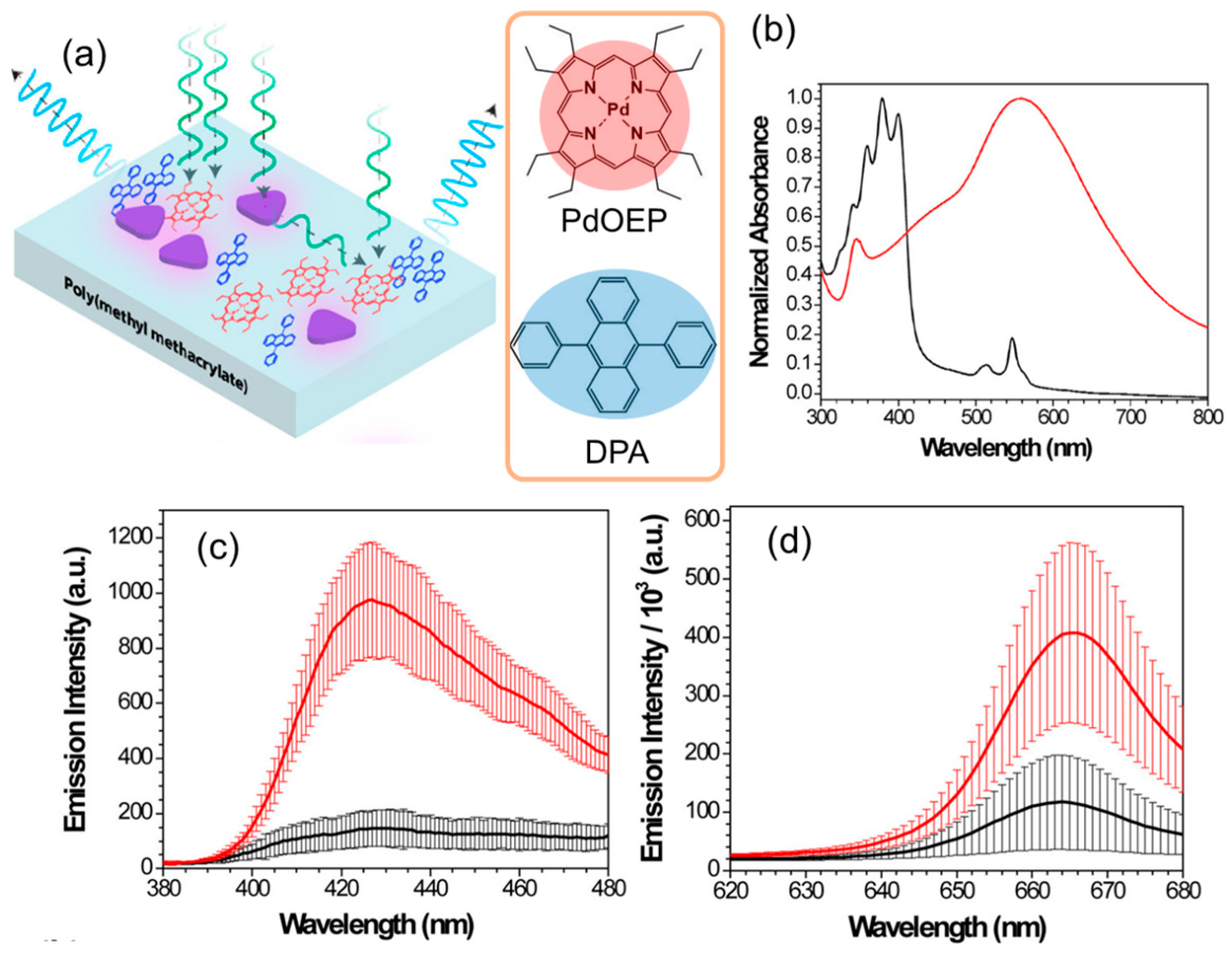

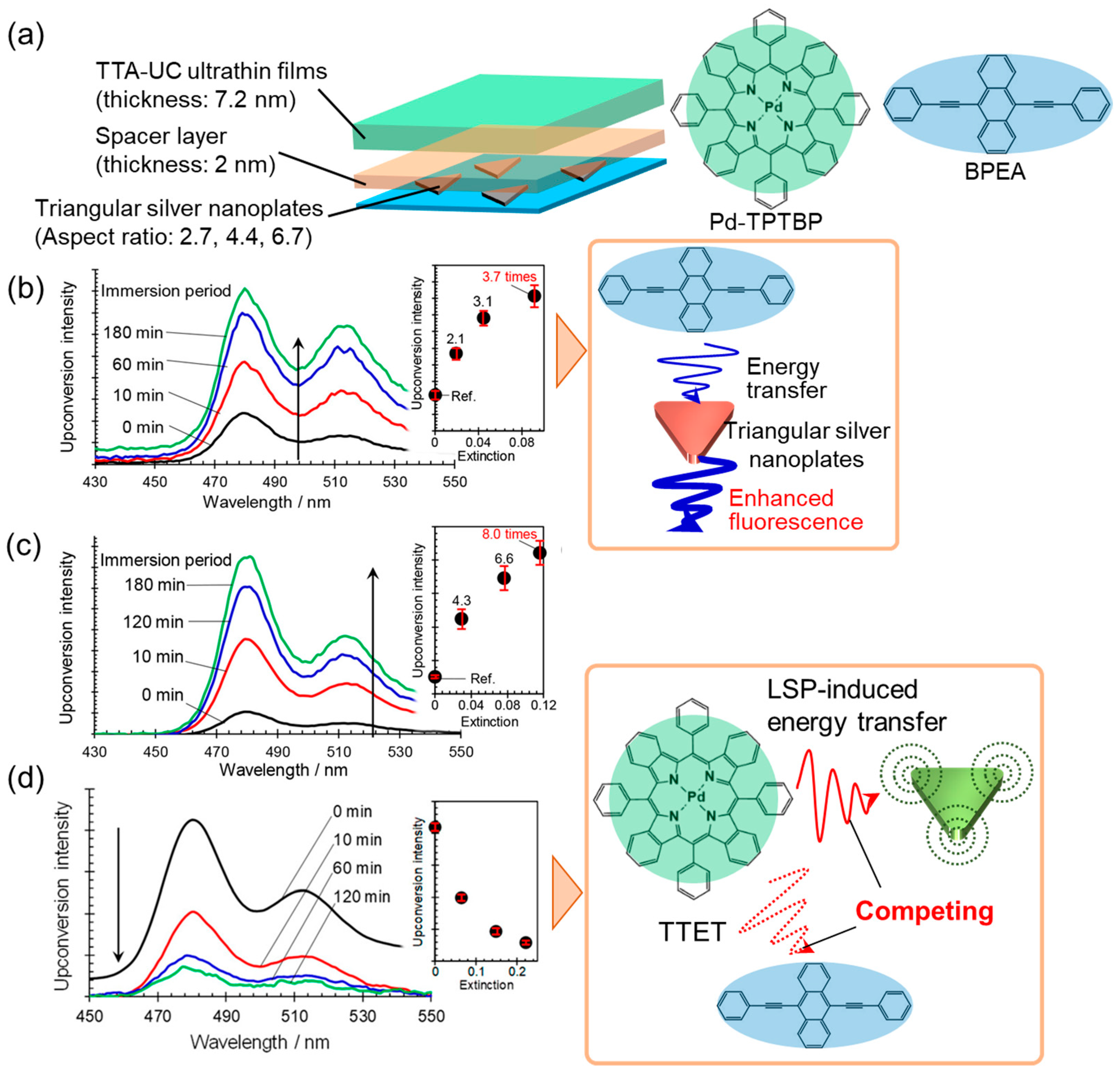

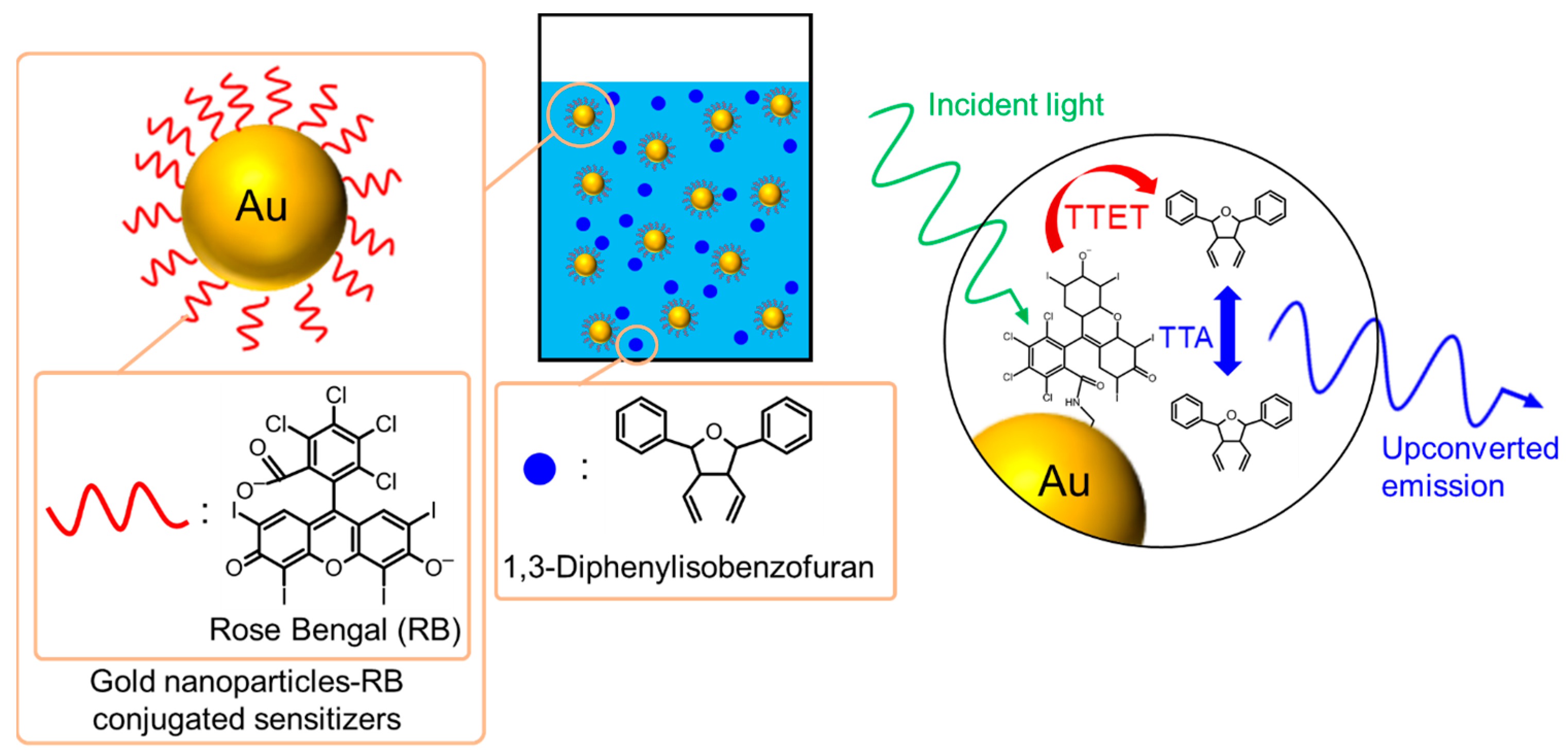
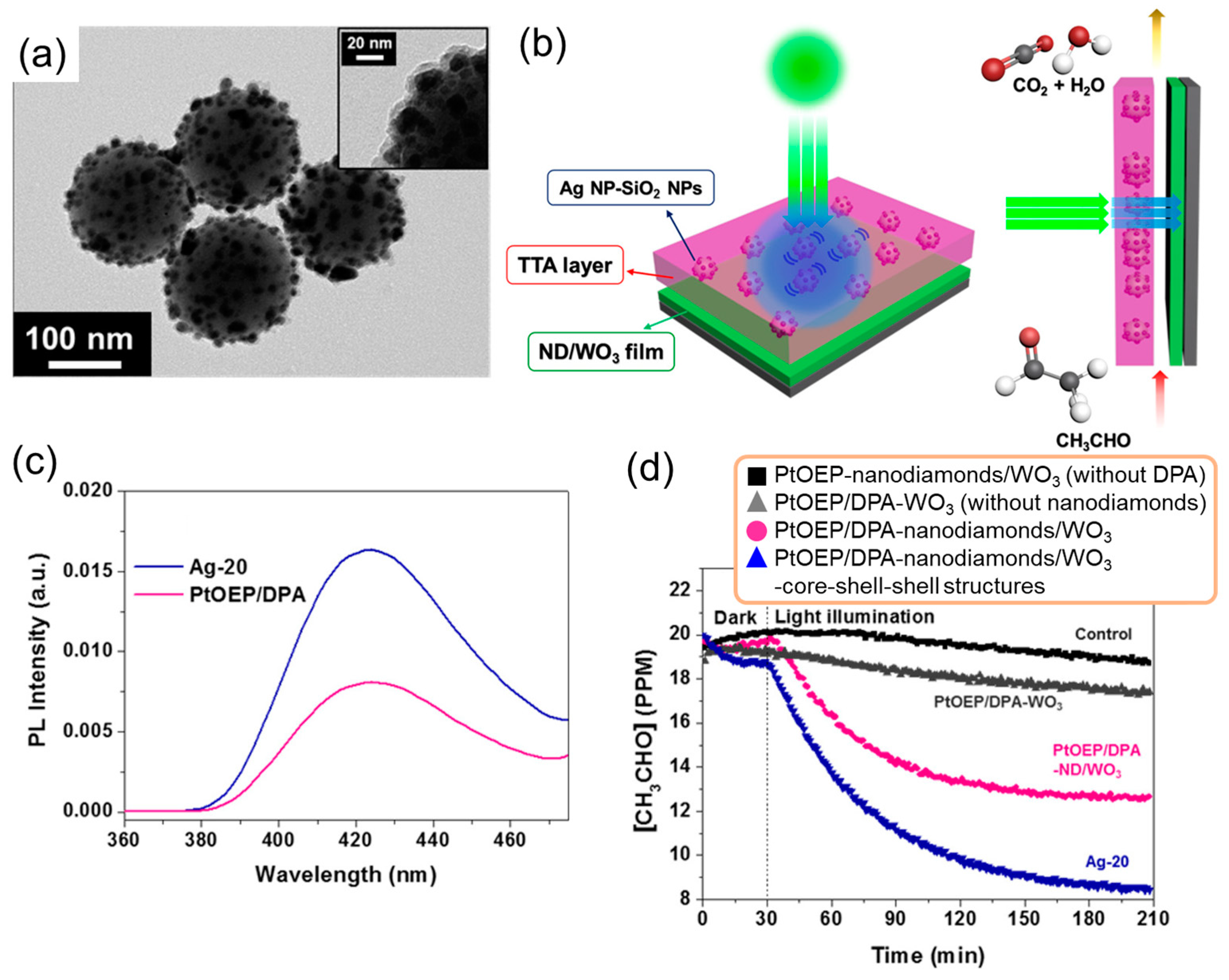
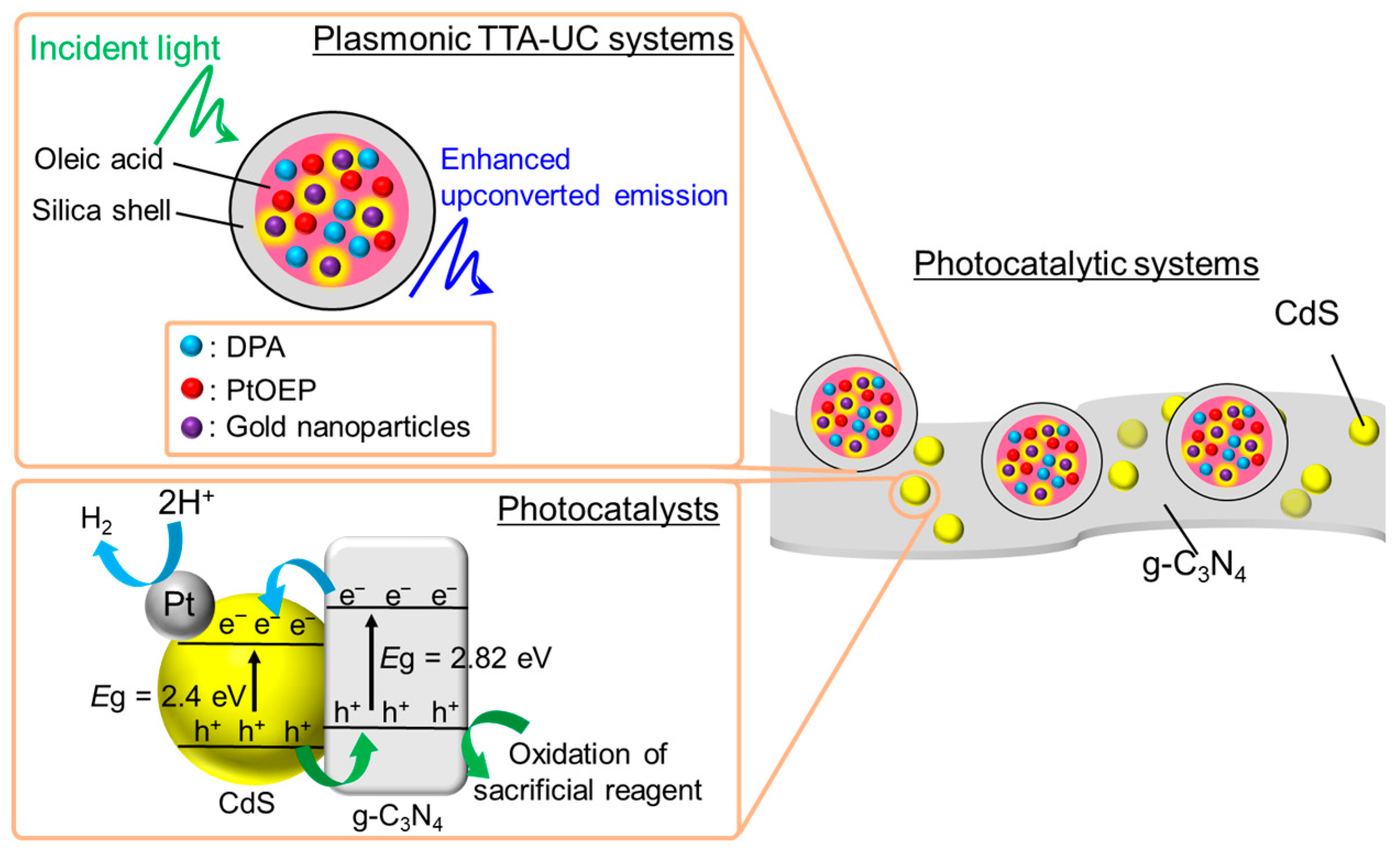
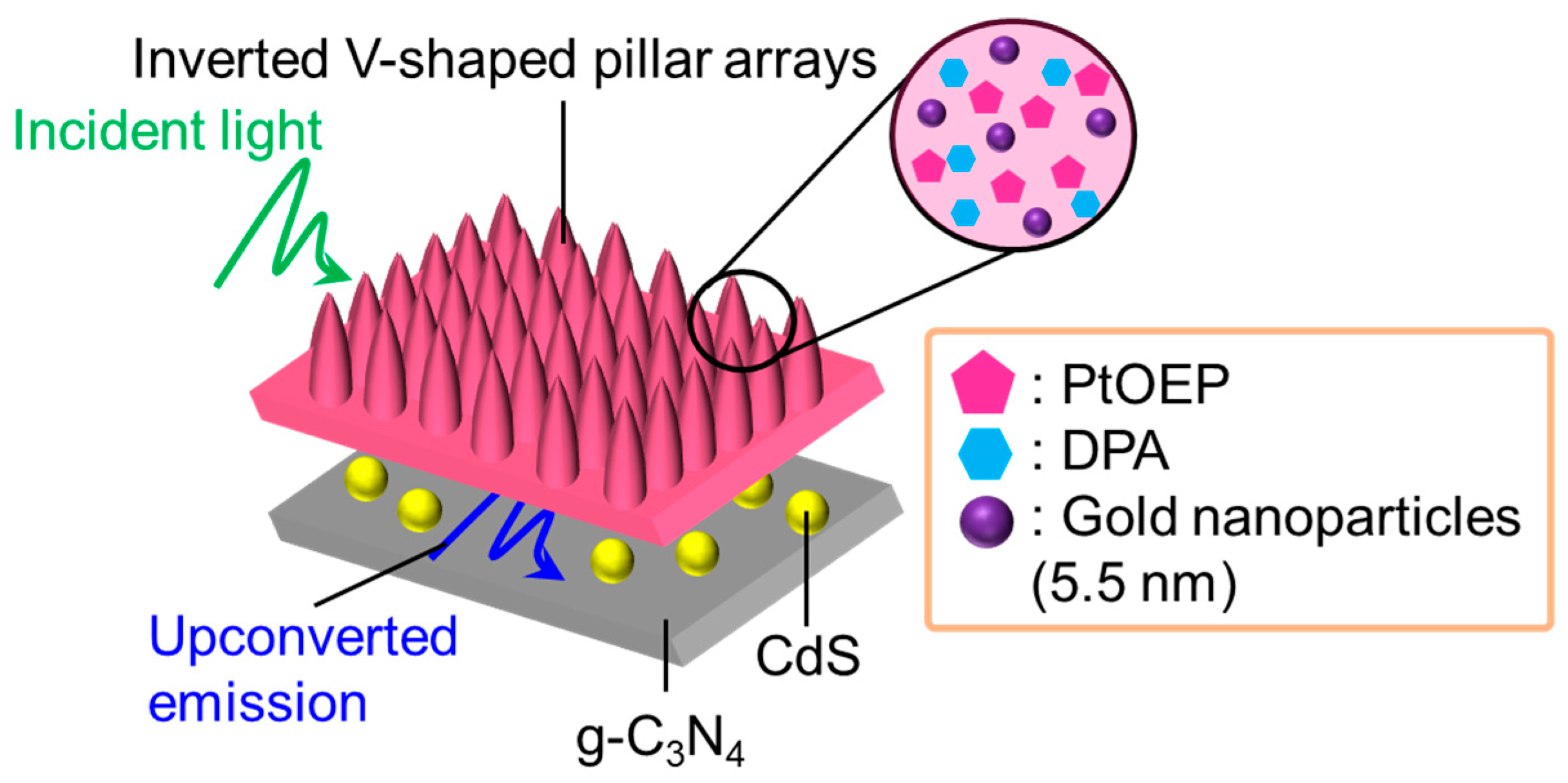
Disclaimer/Publisher’s Note: The statements, opinions and data contained in all publications are solely those of the individual author(s) and contributor(s) and not of MDPI and/or the editor(s). MDPI and/or the editor(s) disclaim responsibility for any injury to people or property resulting from any ideas, methods, instructions or products referred to in the content. |
© 2023 by the authors. Licensee MDPI, Basel, Switzerland. This article is an open access article distributed under the terms and conditions of the Creative Commons Attribution (CC BY) license (https://creativecommons.org/licenses/by/4.0/).
Share and Cite
Honda, J.; Sugawa, K.; Tahara, H.; Otsuki, J. Plasmonic Metal Nanostructures Meet Triplet–Triplet Annihilation-Based Photon Upconversion Systems: Performance Improvements and Application Trends. Nanomaterials 2023, 13, 1559. https://doi.org/10.3390/nano13091559
Honda J, Sugawa K, Tahara H, Otsuki J. Plasmonic Metal Nanostructures Meet Triplet–Triplet Annihilation-Based Photon Upconversion Systems: Performance Improvements and Application Trends. Nanomaterials. 2023; 13(9):1559. https://doi.org/10.3390/nano13091559
Chicago/Turabian StyleHonda, Jotaro, Kosuke Sugawa, Hironobu Tahara, and Joe Otsuki. 2023. "Plasmonic Metal Nanostructures Meet Triplet–Triplet Annihilation-Based Photon Upconversion Systems: Performance Improvements and Application Trends" Nanomaterials 13, no. 9: 1559. https://doi.org/10.3390/nano13091559
APA StyleHonda, J., Sugawa, K., Tahara, H., & Otsuki, J. (2023). Plasmonic Metal Nanostructures Meet Triplet–Triplet Annihilation-Based Photon Upconversion Systems: Performance Improvements and Application Trends. Nanomaterials, 13(9), 1559. https://doi.org/10.3390/nano13091559





